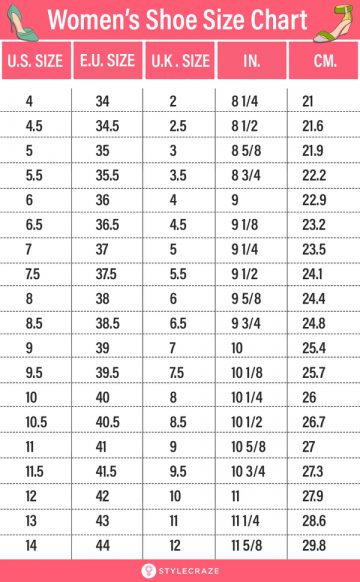Shoe Size Calculator
You might have experienced the discomfort of wearing ill-fitting shoes at some point in your life. Wearing the wrong-sized shoes can hurt your feet and have long-term consequences. Research shows that a sizable portion of the population wears shoes that are bigger or smaller than their correct foot size, which consequently leads to foot pain and associated disorders (1). This issue is further amplified while shopping for shoes online or abroad, due to variations in shoe-size standards. However, using an online show size calculator may help mitigate the issue. You can use this calculator for accurate conversions and get yourself perfectly fitting shoes. Scroll down and take a look.
In This Article
How Does The Shoe Size Calculator Work?
The internet is rife with readily available shoe-size converters that use US, UK, European, and Australian standard shoe sizes as these are a few commonly used standards worldwide. Here are the common formulas for finding the right shoe size as per US, UK, and EU standards:
Note that the sizes are determined by the length of the foot in inches and 1 inch = 25.4 millimeters.
Inches = millimeters / 25.4
- US Sizing
US Male: 3 x foot length in inches – 22
US Female: 3 x foot length in inches – 21
US Child: 3 x foot length in inches – 9.67
- UK Sizing
UK Adult: 3 x foot length in inches – 23
UK Child: 3 x foot length in inches – 10
- EU Sizing
EU Size = 1.27 x (UK Size + 23) + 2
How To Use The Shoe Size Calculator
To use the shoe-size converters online, follow the procedure given below –
- Choose who you need the shoe-size calculator for. Select from the between Men, Women, or Child from the drop-down.
- Select the sizing system (of the relevant country) for which you already know the shoe size. For instance, if you know your US shoe size, choose US.
- Now enter the US shoe size value that you know. For example, if your shoe size in the US is 7, enter 7 in the box.
- Now choose the sizing system of the relevant country. For instance, if you want to determine your UK shoe size from your US size value, choose UK.
- Press enter or calculate and the shoe size converter will display the result within seconds.
Note: Though the Indian shoe size chart adopts the UK sizing system, there may be slight discrepancies in sizing among various brands while measuring.
If you find pre-calculated values more convenient, find basic size charts for men, women, and children below. It displays sizing equivalents from the US, Europe, and the UK.
Men’s Shoe Size Chart
Women’s Shoe Size Chart
Children’s Shoe Sizes Chart
Fashion stylist, Eleonora Fiano, says, “It’s important to follow some guidelines to ensure accuracy and comfort when buying shoes. You should be able to measure your feet accurately using a ruler or measuring tape to measure the length of your foot in centimeters or inches. Ensure your foot is flat on the ground and that you’re wearing the type of socks you intend to wear with the shoes. Don’t forget to measure the foot width especially if you have wider or narrower feet. Measure the width at the widest part of your foot.”
Continue to the following section for a step-wise guide on manually measuring your shoe size.
How To Measure Shoe Size And Width At Home
You can simply determine your shoe size using a measuring tape at home. Follow the detailed instructions below for accurate measurements –
- Take a piece of chart paper and place your feet on it. Keep the paper steady and ensure it does not slip.
- Take a pen and trace the outline of your foot holding the pen straight up at 90 degrees. Put your foot perpendicular to any lines on your paper.
- Use a marker to draw two straight lines through the outline, each touching the high points of the outline. So, one line connects the top and bottom high points and the other connects the left and right high points of the outline.
- Now measure the length and breadth of your foot by measuring the length of these two lines. The heel to the tallest toe is the length of your toe, while the other is the breadth.
- You can subtract 3/16th of an inch from both numbers you get or you can simply enter the measurements into the calculator to find the respective shoe size.
Tips For The Perfect Shoe Fit
- As you grow older or lose or gain weight, your feet change. This is the reason why measuring your shoe size before purchasing a new pair of shoes is ideal.
- Many people have one foot larger than the other so before buying a new pair of shoes, consider this aspect.
- Make the salesperson measure both of your feet because one can be bigger than the other one.
- Consider the shape of the shoes. Shoes that do not match your foot shape may cause discomfort. For example, a narrow-tip shoe for wide feet can cause extreme pain on the toes. In the long term, such issues may lead to foot disorders.
- Pay attention to width as well as length. Many people buy shoes simply according to the length and ignore the width.
- Many people buy tight shoes, expecting them to stretch after a few uses. This is not healthy for your feet. Ensure your shoes are comfortable to walk in at the time of purchase.
- Consider how your foot slips into the shoe to find the best fit. Your feet must feel secure and the shoes must stay in place while you walk.
- Before buying the shoes, wear them and walk a few rounds around the store to make sure that they are a good fit.
- Choose shoes made with soft and breathable materials. Tight and hard materials will hurt your feet.
- In the case of buying new formal shoes, wear the socks you might pair with them while trying them out.
- Examine the soles. Make sure they are sturdy as well as flexible to allow lasting wear and comfortable movement.
Eleonora Fiano adds, “Keep in mind that different types of shoes may have slightly different sizing requirements. Some styles may require a different size than your standard size. Sizes also vary by brand, so if you’re shopping for a particular brand, check their sizing chart on their official website. Different brands may have variations in sizing, so it’s important to refer to the brand’s guidelines. Before making a purchase, read user reviews and recommendations for the specific shoe model you’re interested in. This can provide valuable insights into whether the shoe runs true to size or if there are any.”
Drawbacks Of Shoe Size Converters
Although there are ample shoe-size converters made as per common sizing standards, there are certain issues that people might face. Here are a few factors that impact the accuracy of these calculators:
- Shoe conversion systems are not fully standardized. Shoe sizes might differ slightly as per different manufacturers.
- The biggest issue with children’s shoe sizes is that the growth rate of each child is different. Fast-growing kids might need bigger shoes than the others. Rather than considering conversion charts, it is better to measure their sizes manually.
- People only consider foot length while measuring and purchasing the shoes. Some people have broad feet while some have narrow and thus, it is important to measure the width of feet before purchasing the shoes. Sometimes wider feet require larger-sized shoes for a comfortable fit.
Why Is It Important To Wear The Right Shoe Size?
Wearing the right shoes is very important, especially if you walk a lot. Wearing ill-fitting shoes for extended periods may lead to blisters, shoe bites, and painful or achy heels. When you wear tight shoes for a long period, it can worsen serious conditions such as arthritis and lead to foot ulcerations in people with diabetes (2), (3). As our feet are responsible for bearing our entire body weight while enabling its movement, it is important to wear comfortable and breathable shoes.
Wearing tight shoes can have short or long-term consequences on your body. It is necessary to wear correctly sized shoes to avoid such issues. Our shoe size calculator uses conversion values from the US, UK, and European shoe sizing standards. These values are commonly used across the globe and may help you find the closest fit for your feet. However, keep in mind that these values are not universally standardized since many manufacturers also use their own sizing systems, so you may not always get the most accurate results. Further, make a practice of regularly checking your shoe size while purchasing new pairs as even a slight difference in your height or weight may result in a shoe size change.
Frequently Asked Questions
What’s the biggest shoe size in the world?
Jeison Orlando Rodríguez Hernandez from Venezuela holds the Guinness World Record for the largest feet of a living person. His feet measure nearly 16 inches, and his shoe size is 26. However, Robert Wadlow holds the record for the biggest feet ever. His feet measured 18.5 inches each.
What is the average shoe size for a man?
The average shoe size for a man in the US is 10.5.
What are true-to-size shoes?
The shoes that are true to size have accurate measurements that run for the size. They are neither too big nor too small.
Does 0.5 shoe size make a difference?
Not really. As it is just a difference of 1/8th of an inch, it depends on the shoe material if it can accommodate your foot comfortably.
References
Articles on StyleCraze are backed by verified information from peer-reviewed and academic research papers, reputed organizations, research institutions, and medical associations to ensure accuracy and relevance. Read our editorial policy to learn more.
- Incorrectly fitted footwear, foot pain and foot disorders: a systematic search and narrative review of the literature
https://www.ncbi.nlm.nih.gov/pmc/articles/PMC6064070/ - Arthritis, Foot Pain & Shoe Wear: Current Musculoskeletal Research on Feet
https://www.ncbi.nlm.nih.gov/pmc/articles/PMC3132870/ - Medical-grade footwear: the impact of fit and comfort
https://www.ncbi.nlm.nih.gov/pmc/articles/PMC5217416/











